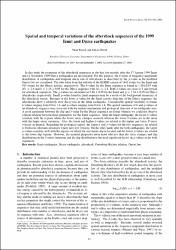| dc.contributor.author | Öztürk, Serkan | |
| dc.contributor.author | Bayrak, Yusuf | |
| dc.date.accessioned | 2014-09-11T09:22:03Z | |
| dc.date.available | 2014-09-11T09:22:03Z | |
| dc.date.issued | 2004 | |
| dc.identifier.uri | https://hdl.handle.net/20.500.12440/131 | |
| dc.identifier.uri | https://earth-planets-space.springeropen.com/articles | |
| dc.description.abstract | In this study the properties of the aftershock sequences in the first five months after the 17 August 1999 'Izmit and 12 November 1999 D¨uzce earthquakes are investigated. For this purpose, the b-value of frequency-magnitude distribution of earthquakes and temporal decay rate of aftershocks as described by the p-value in the modified Omori law are calculated. The data taken from the website of the KOERI consist of 1841 events for the 'Izmit and 913 events for the D¨uzce activity, respectively. The b-value for the 'Izmit sequence is found as 1.10±0.03 with Mc = 2.6 and b = 1.16 ± 0.05 for the D¨uzce sequence with Mc = 2.8. Both b-values are close to 1 and typical for aftershock sequences. The p-values are calculated as 0.86 ± 0.05 for the 'Izmit and p = 1.34 ± 0.09 for D¨uzce aftershocks, respectively. Small p-value found in 'Izmit sequence may be a result of the background seismicity of the aftershock region. Because of the lower p-value for the 'Izmit activity than that of the D¨uzce sequence, the aftershocks show a relatively slow decay rate in the 'Izmit earthquake. Considerable spatial variability is found, b-values ranging from 0.8 to 1.6, and p-values ranging from 0.4 to 1.4. The spatial variations of b and p-values of an aftershock sequence may associate with the rupture mechanism and geological structure of an earthquake area. A good agreement between the slip and b-value for the D¨uzce sequence are found whereas we could not observe a linear relation between these parameters for the 'Izmit sequence. After the 'Izmit earthquake, the larger b-values correlate with the regions where the lower stress changes occurred whereas the lower b-values are in the areas with the larger stress variations. Also, the lower and higher b-values are related to the higher and lower P-wave velocity in general. Regarding the geological aspect, the larger b and p-values for the two sequences are related to Holocene alluvium structures which have low velocity. On the other hand, after the both earthquakes, the larger p-values correlate well with the regions on which the maximum slip is located and the lower p-values are related to the lower slip regions. However, the material properties seem more effective than the stress changes and slip distributions in the b-value variations and the slip distribution is the most significant factor on p-values in the both sequences. | en_US |
| dc.language.iso | eng | en_US |
| dc.publisher | Earth Planets and Space | en_US |
| dc.rights | info:eu-repo/semantics/openAccess | en_US |
| dc.subject | Izmit earthquake | en_US |
| dc.subject | D¨uzce earthquake | en_US |
| dc.subject | aftershock | en_US |
| dc.subject | Gutenberg-Richter relation | en_US |
| dc.subject | Omori law. | en_US |
| dc.title | Spatial and temporal variations of the aftershock sequences of the 1999 İzmit and Düzce earthquakes | en_US |
| dc.type | article | en_US |
| dc.relation.publicationcategory | Makale - Uluslararası Hakemli Dergi - Kurum Öğretim Elemanı | en_US |
| dc.department | Fakülteler, Mühendislik ve Doğa Bilimleri Fakültesi, Jeofizik Mühendisliği Bölümü | en_US |
| dc.contributor.institutionauthor | Öztürk, Serkan | |


















